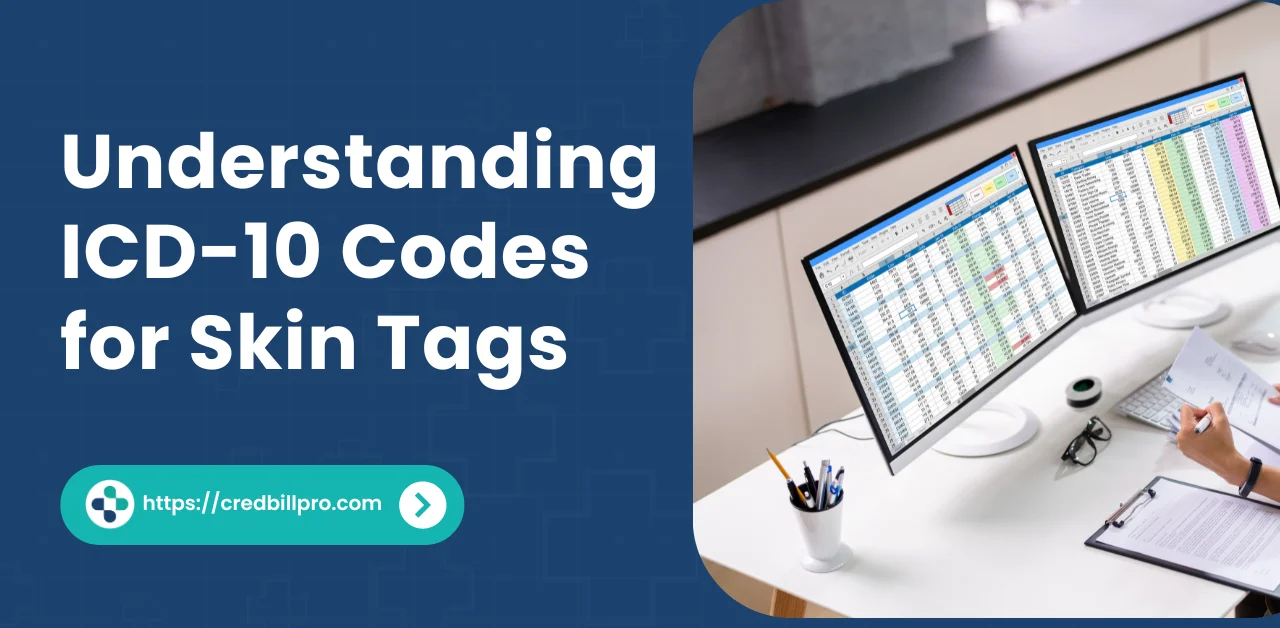The ICD-10 code L91.8 is essential for accurately documenting and treating skin tags in medical records. This guide dives deep into its applications, related codes, and the clinical significance of proper coding.
What Are Skin Tags?
Skin tags, medically known as acrochordons, are benign, non-cancerous growths of skin that often develop in areas of friction, such as the neck, armpits, and groin. These small, soft, flesh-colored lesions are generally harmless but can cause discomfort or cosmetic concerns.
Causes and Risk Factors:
- Friction between skin surfaces
- Obesity and diabetes
- Hormonal changes (e.g., pregnancy)
- Genetic predisposition
Differentiation Table:
| Feature | Skin Tags | Warts | Moles |
|---|---|---|---|
| Cause | Friction, genetics | HPV infection | Melanocyte clusters |
| Texture | Soft, smooth | Rough, irregular | Smooth or raised |
| Risk of Cancer | None | Rare | Variable |
ICD-10 Code for Skin Tags: L91.8 Explained
The ICD-10 code L91.8 belongs to the category of “Other hypertrophic disorders of the skin,” explicitly used to document skin tags.
Key Features of L91.8:
- Category: Dermatological coding
- Purpose: Identifies skin tags in medical billing
- Common Use: Outpatient dermatology clinics and insurance claims
Complete List of Skin Tag ICD-10 Codes
Here is a comprehensive list of related codes for skin tags and similar conditions:
| ICD-10 Code | Description |
|---|---|
| L91.8 | Skin tags (Acrochordons) |
| L91.0 | Hypertrophic scars and keloids |
| L90.8 | Other atrophic disorders of skin |
| D23.9 | Benign neoplasm of skin, unspecified |
Clinical Applications of ICD-10 Code L91.8
- Accurate Diagnosis:
- Distinguishing skin tags from other lesions, such as warts or moles.
- Treatment Documentation:
- Cryotherapy, excision, or electrocautery for cosmetic removal.
- Insurance Claims:
- Ensures coverage for medically necessary removal when skin tags cause discomfort or infection.
ICD-10 Coding Guidelines for Skin Conditions
- Modifiers: When coding, use appropriate modifiers to indicate the procedure’s complexity.
- Combination Codes: Combine with symptom codes like itching (L29.9) when applicable.
- Avoiding Errors: Ensure accurate documentation to avoid claim rejections.
Complete List of Skin Tag ICD-10 Codes
| Skin Tag Location/Condition | ICD-10 Code | Reason/Explanation | Billable/Unbillable |
|---|---|---|---|
| Neck | L91.8 | Hypertrophic skin disorders can include skin tags in areas like the neck. | Billable |
| Irritated | L91.8 | Irritated skin tags fall under “Other hypertrophic disorders of the skin.” | Billable |
| Inflamed | L98.8 | Inflamed skin tags can be coded under “Other specified disorders of skin.” | Billable |
| Eyelid | D23.9 | Benign neoplasm of skin; covers skin tags in specific locations like the eyelid. | Billable |
| Face | D23.9 | Benign neoplasm of skin, unspecified, applies to facial skin tags. | Billable |
| Left Axilla | L91.8 | Hypertrophic skin disorders, such as skin tags, may occur in the axilla. | Billable |
| Bleeding | L98.8 | Bleeding skin tags are considered “Other specified disorders of the skin.” | Billable |
| Rectal | K64.4 | Residual hemorrhoidal skin tags are often found in the rectal region. | Billable |
| Genital | L98.8 | Genital skin tags fall under “Other specified disorders of the skin.” | Billable |
| Unspecified | D23.9 | Unclassified benign neoplasm of skin, including unspecified skin tags. | Billable |
| Labial | L98.8 | Skin tags on the labia are classified as “Other specified disorders of the skin.” | Billable |
| Groin | L91.8 | Hypertrophic disorders include skin tags in the groin area. | Billable |
| Back | D23.9 | Benign neoplasm of skin; back is included under unspecified locations. | Billable |
| Perianal | K64.4 | Perianal skin tags are classified under residual hemorrhoidal skin tags. | Billable |
| Ear | D23.9 | Benign neoplasm of skin, unspecified, includes locations like the ear. | Billable |
| Anus | K64.4 | Residual hemorrhoidal skin tags commonly occur around the anus. | Billable |
This table offers a quick reference for accurately coding skin tags based on their location or condition, ensuring compliance with ICD-10 guidelines.
Billable ICD-10 Codes for Skin Tags
Neck (L91.8)
Skin tags frequently appear on the neck due to constant friction from clothing, jewelry, or skin folds. The ICD-10 code L91.8 classifies these as hypertrophic skin disorders, making treatments such as excision or cryotherapy eligible for insurance reimbursement. This coding is essential for documenting procedures, especially when skin tags cause irritation, snagging, or cosmetic concerns.
Irritated Skin Tags (L91.8)
Skin tags can become irritated due to friction, pressure, or trauma, leading to redness, discomfort, or bleeding. These cases fall under L91.8, “Other hypertrophic disorders of the skin.” This code allows healthcare providers to document and bill for treatments like removal or topical care aimed at alleviating irritation.
Inflamed Skin Tags (L98.8)
When skin tags become inflamed due to infection or repeated trauma, they are coded under L98.8, categorized as “Other specified disorders of the skin.” This classification ensures that treatments, including antibiotics or surgical removal, are billable. Proper documentation is crucial in these cases, as inflamed tags may mimic other skin conditions.
Eyelid (D23.9)
Skin tags that develop on the eyelids are often removed for both medical and cosmetic reasons. The ICD-10 code D23.9, which pertains to benign neoplasms of the skin, applies here. Removal might be necessary if the tags obstruct vision or cause discomfort during blinking, and this code ensures the procedure is billable.
Face (D23.9)
Facial skin tags can be aesthetically displeasing and are classified under D23.9, covering benign neoplasms of the skin. While generally harmless, these tags might require removal for medical or cosmetic purposes, such as preventing irritation during shaving or skincare routines. This code enables billing for their treatment.
Left Axilla (L91.8)
The left axilla, or armpit, is a common location for skin tags due to constant friction and moisture. These are classified under L91.8, allowing for billing when removal is necessary to address discomfort, odor issues, or hygiene challenges. Treatment options include cryotherapy, excision, or electrosurgery.
Bleeding Skin Tags (L98.8)
Skin tags that bleed, often caused by irritation or accidental trauma, are coded under L98.8 as “Other specified disorders of the skin.” These cases often require prompt attention to prevent infection. Treatments such as cauterization or excision are billable under this code, ensuring patients receive necessary care.
Rectal (K64.4)
Residual hemorrhoidal skin tags, common in the rectal area, are documented under the code K64.4. These tags can cause hygiene difficulties or discomfort during bowel movements. Removal is typically performed via outpatient procedures and is fully billable when documented correctly.
Genital (L98.8)
Skin tags in the genital area can cause significant discomfort or embarrassment for patients. These are classified under L98.8, covering “Other specified disorders of the skin.” Removal procedures are often billable, ensuring access to treatments like surgical excision or laser therapy.
Labial (L98.8)
Skin tags on the labia are categorized under L98.8 and may require removal for both medical and aesthetic reasons. These growths can interfere with personal hygiene or cause discomfort during physical activities, making their treatment billable under this code.
Groin (L91.8)
Skin tags in the groin area are a common issue, particularly in individuals who experience frequent chafing or have underlying conditions like obesity. These tags are coded as L91.8, ensuring reimbursement for their removal when they cause irritation or secondary infections.
Back (D23.9)
The back is a common site for skin tags, especially in areas prone to friction from clothing or straps. These tags are coded under D23.9, covering benign neoplasms of the skin. Removal is billable when performed for medical or cosmetic reasons, ensuring proper documentation.
Perianal (K64.4)
Skin tags around the perianal region are typically linked to hemorrhoidal issues and are coded under K64.4. These tags can be problematic for hygiene and comfort, particularly after bowel movements. Their removal is billable when required to improve quality of life or resolve medical concerns.
Ear (D23.9)
Skin tags on the ear are uncommon but are classified under D23.9 as benign neoplasms. They can be removed for cosmetic or functional reasons, such as interference with wearing earrings or glasses, and the procedure is billable under this code.
Anus (K64.4)
Anus skin tags are similar to perianal tags and are often associated with residual hemorrhoidal conditions. These are coded under K64.4 and are billable when removal is necessary for hygiene or comfort, especially in cases of irritation or bleeding.
Non-Billable ICD-10 Codes for Skin Tags
Miliaria Rubra (L72.3)
Miliaria rubra, or heat rash, is often mistaken for skin tags due to its appearance. However, this condition is entirely different and is classified under L72.3. Since it is not a skin tag, it is non-billable for treatments related to skin tags.
Hypertrophic Scar (L91.0)
Hypertrophic scars, raised areas of skin resulting from injury or surgery, are coded as L91.0. Although they may resemble skin tags, they are a separate condition and not billable under skin tag-related ICD-10 codes.
Epidermal Cyst (L72.0)
Epidermal cysts, which are small lumps beneath the skin, are distinct from skin tags and classified under L72.0. These cysts require different treatment approaches and are non-billable under skin tag codes.
Unspecified Skin Tags (D23.9)
Unspecified skin tags are coded under D23.9, but when their location or condition isn’t clearly documented, they may not be billable. Proper documentation is critical to ensure accurate coding and eligibility for reimbursement.
Key Takeaways
- L91.8 is the primary ICD-10 code for skin tags under “Other hypertrophic disorders of the skin.”
- Skin tags are classified as billable or non-billable based on location and condition.
- Billable codes include skin tags in areas like the neck, eyelid, and genital regions.
- Non-billable codes cover conditions like hypertrophic scars (L91.0) or epidermal cysts (L72.0).
- Accurate coding ensures proper insurance reimbursement and medical record documentation.
- Some conditions, like rectal and perianal tags, fall under specific codes (K64.4).
- Misclassification, such as labeling a cyst as a skin tag, can result in billing errors.
- Familiarity with ICD-10 codes enhances compliance and reduces claims rejections.
FAQs
What is the ICD-10 code for skin tags?
The primary ICD-10 code for skin tags is L91.8, classified under “Other hypertrophic disorders of the skin.”
Are skin tags always billable under ICD-10 codes?
No, only specific conditions and locations are billable, such as tags on the neck (L91.8) or eyelids (D23.9). Others, like hypertrophic scars (L91.0), are non-billable as skin tags.
What code applies to inflamed or irritated skin tags?
Inflamed or irritated skin tags are coded as L98.8, under “Other specified disorders of the skin,” and are billable.
Are rectal skin tags billable?
Yes, rectal skin tags are coded as K64.4 and are considered billable, often linked to residual hemorrhoidal conditions.
What makes a skin tag code non-billable?
Non-billable codes apply when the condition isn’t directly classified as a skin tag, such as L72.0 for epidermal cysts or L91.0 for hypertrophic scars.
What ICD-10 code is used for unspecified skin tags?
Unspecified skin tags may fall under D23.9, but lack of clear documentation could make them non-billable.
Why is accurate coding important for skin tags?
Accurate coding ensures proper insurance claims processing, avoids rejections, and supports medical record accuracy.








